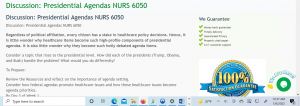Discussion: Presidential Agendas NURS 6050
Discussion: Presidential Agendas NURS 6050
Regardless of political affiliation, every citizen has a stake in healthcare policy decisions. Hence, it is little wonder why healthcare items become such high-profile components of presidential agendas. It is also little wonder why they become such hotly debated agenda items.
Consider a topic that rises to the presidential level. How did each of the presidents (Trump, Obama, and Bush) handle the problem? What would you do differently?
To Prepare:
Review the Resources and reflect on the importance of agenda setting.
Consider how federal agendas promote healthcare issues and how these healthcare issues become agenda priorities.
By Day 3 of Week 1
Post your response to the discussion question: Consider a topic that rises to the presidential level. How did each of the presidents (Trump, Obama, and Bush) handle the problem? What would you do differently?
By Day 6 of Week 1
Respond to at least two of your colleagues* on two different days by expanding on their response and providing an example that supports their explanation or respectfully challenging their explanation and

Discussion Presidential Agendas NURS 6050
providing an example.
*Note: Throughout this program, your fellow students are referred to as colleagues.
Submission and Grading Information
Grading Criteria
Click here to ORDER NOW FOR AN ORIGINAL PAPER ASSIGNMENT: Discussion: Presidential Agendas NURS 6050
To access your rubric:
Week 1 Discussion Rubric
Post by Day 3 and Respond by Day 6 of Week 1
To participate in this Discussion:
Week 1 Discussion
Module 1: Agenda Setting (Weeks 1-2)
Laureate Education (Producer). (2018). Meet the Experts: Pioneers in Policy [Video file]. Baltimore, MD: Author.
Laureate Education (Producer). (2018). The Policy Process [Video file]. Baltimore, MD: Author.
Learning Objectives
Students will:
Compare U.S. presidential agenda priorities
Evaluate ways that administrative agencies help address healthcare issues
Analyze how healthcare issues get on administrative agendas
Identify champions or sponsors of healthcare issues
Create fact sheets for communicating with policymakers or legislators
Justify the role of the nurse in agenda setting for healthcare issues
Due By
Assignment
Week 1, Days 1–2
Read/Watch/Listen to the Learning Resources.
Compose your initial Discussion post.
Week 1, Day 3
Post your initial discussion post.
Week 1, Days 4-5
Review peer Discussion posts.
Compose your peer Discussion responses.
Begin to compose your Assignment.
Week 1, Day 6
Post at least two peer Discussion responses on two different days (and not the same day as the initial post).
Continue to compose your final draft of your Assignment.
Week 1, Day 7
Wrap up Discussion.
Week 2, Day 1–6
Continue to compose your Assignment.
Week 2, Day 7
Deadline to submit your Assignment.
Learning Resources
Required Readings
Milstead, J. A., & Short, N. M. (2019). Health policy and politics: A nurse’s guide (6th ed.). Burlington, MA: Jones & Bartlett Learning.
Chapter 1, “Informing Public Policy: An Important Role for Registered Nurses” (pp. 11–13 only)
Chapter 2, “Agenda Setting: What Rises to a Policymaker’s Attention?” (pp. 17–36)
Chapter 10, “Overview: The Economics and Finance of Health Care” (pp. 171–180)
Chapter 12, “An Insider’s Guide to Engaging in Policy Activities”
“Creating a Fact Sheet” (pp. 217-221)
DeMarco, R., & Tufts, K. A. (2014). The mechanics of writing a policy brief. Nursing Outlook, 62(3), 219–224. doi:10.1016/j.outlook.2014.04.002
Kingdon, J.W. (2001). A model of agenda-setting with applications. Law Review M.S.U.-D.C.L., 2(331)
Lamb, G., Newhouse, R., Beverly, C., Toney, D. A., Cropley, S., Weaver, C. A., Kurtzman, E., … Peterson, C. (2015). Policy agenda for nurse-led care coordination. Nursing Outlook, 63(4), 521–530. doi:10.1016/j.outlook.2015.06.003.
O’Rourke, N. C., Crawford, S. L., Morris, N. S., & Pulcini, J. (2017). Political efficacy and participation of nurse practitioners. Policy, Politics, and Nursing Practice, 18(3), 135–148. doi:10.1177/1527154417728514
Institute of Medicine (US) Committee on Enhancing Environmental Health Content in Nursing Practice, Pope, A. M., Snyder, M. A., & Mood, L. H. (Eds.). (n.d.). Nursing health, & environment: Strengthening the relationship to improve the public’s health.
USA.gov. (n.d.). A-Z index of U.S. government departments and agencies. Retrieved September 20, 2018, from https://www.usa.gov/federal-agencies/a
USA.gov. (n.d.). Executive departments. Retrieved September 20, 2018, from https://www.usa.gov/executive-departments
The White House. (n.d.). The cabinet. Retrieved September 20, 2018, from https://www.whitehouse.gov/the-trump-administration/the-cabinet/
Document: Agenda Comparison Grid Template (Word document)
